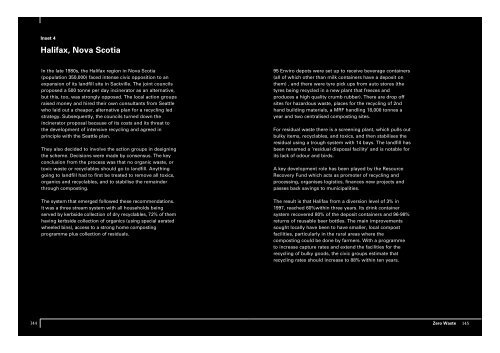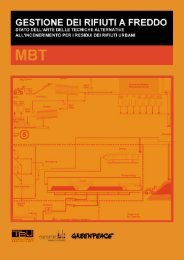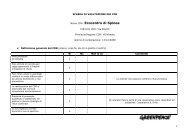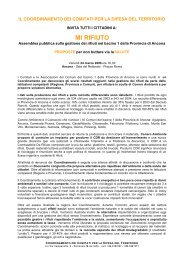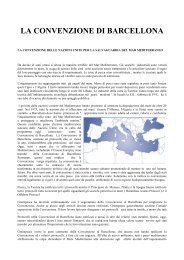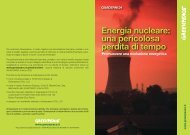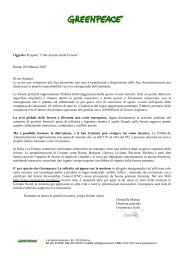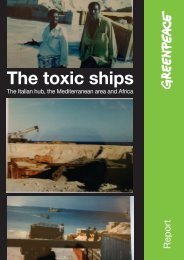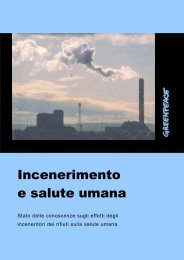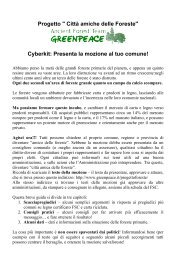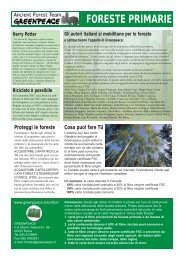Zero Waste by Robin Murray, Greenpeace Environmental Trust 2002
Zero Waste by Robin Murray, Greenpeace Environmental Trust 2002
Zero Waste by Robin Murray, Greenpeace Environmental Trust 2002
Create successful ePaper yourself
Turn your PDF publications into a flip-book with our unique Google optimized e-Paper software.
Inset 4<br />
Halifax, Nova Scotia<br />
In the late 1980s, the Halifax region in Nova Scotia<br />
(population 350,000) faced intense civic opposition to an<br />
expansion of its landfill site in Sackville. The joint councils<br />
proposed a 500 tonne per day incinerator as an alternative,<br />
but this, too, was strongly opposed. The local action groups<br />
raised money and hired their own consultants from Seattle<br />
who laid out a cheaper, alternative plan for a recycling led<br />
strategy. Subsequently, the councils turned down the<br />
incinerator proposal because of its costs and its threat to<br />
the development of intensive recycling and agreed in<br />
principle with the Seattle plan.<br />
They also decided to involve the action groups in designing<br />
the scheme. Decisions were made <strong>by</strong> consensus. The key<br />
conclusion from the process was that no organic waste, or<br />
toxic waste or recyclables should go to landfill. Anything<br />
going to landfill had to first be treated to remove all toxics,<br />
organics and recyclables, and to stabilise the remainder<br />
through composting.<br />
The system that emerged followed these re c o m m e n d a t i o n s .<br />
It was a three stream system with all households being<br />
s e rved <strong>by</strong> kerbside collection of dry recyclables, 72% of them<br />
having kerbside collection of organics (using special aerated<br />
wheeled bins), access to a strong home composting<br />
p rogramme plus collection of residuals.<br />
95 Enviro depots were set up to receive beverage containers<br />
(all of which other than milk containers have a deposit on<br />
them) , and there were tyre pick ups from auto stores (the<br />
tyres being recycled in a new plant that freezes and<br />
produces a high quality crumb rubber). There are drop off<br />
sites for hazardous waste, places for the recycling of 2nd<br />
hand building materials, a MRF handling 18,000 tonnes a<br />
year and two centralised composting sites.<br />
For residual waste there is a screening plant, which pulls out<br />
bulky items, recyclables, and toxics, and then stabilises the<br />
residual using a trough system with 14 bays. The landfill has<br />
been renamed a ’residual disposal facility’ and is notable for<br />
its lack of odour and birds.<br />
A key development role has been played <strong>by</strong> the Resource<br />
Recovery Fund which acts as promoter of recycling and<br />
processing, organises logistics, finances new projects and<br />
passes back savings to municipalities.<br />
The result is that Halifax from a diversion level of 3% in<br />
1997, reached 60%within three years. Its drink container<br />
system recovered 80% of the deposit containers and 96-98%<br />
returns of reusable beer bottles. The main improvements<br />
sought locally have been to have smaller, local compost<br />
facilities, particularly in the rural areas where the<br />
composting could be done <strong>by</strong> farmers. With a programme<br />
to increase capture rates and extend the facilities for the<br />
recycling of bulky goods, the civic groups estimate that<br />
recycling rates should increase to 88% within ten years.<br />
144<br />
<strong>Zero</strong> <strong>Waste</strong><br />
145


